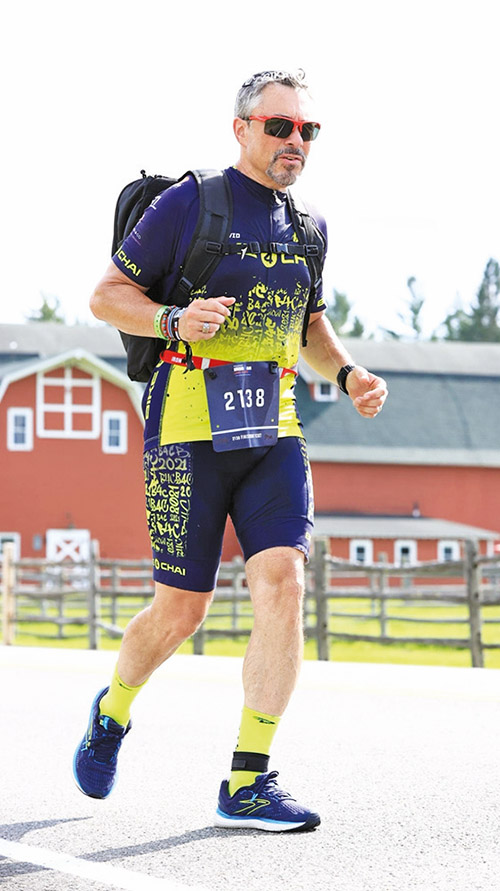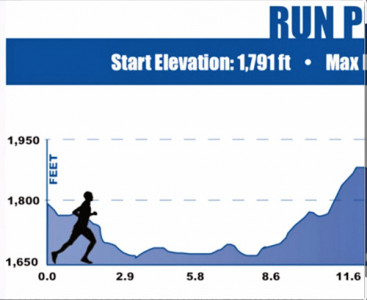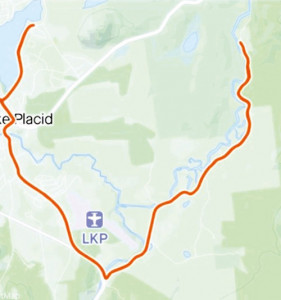
4:17 p.m. (9.5 hours since race start)
Mile 2: As Gene picked up his pace I focused on one thing, I was at the Ironman and I was running the marathon. It didn’t matter that others were passing me, I was pacing ahead of my best finish here, in 2016 of 15:37:50.
I had been racing for over nine and a half hours.

(It has taken you longer to retell the story than it did to complete the race.)
True.
(Did you complete the race, or did you finally fail?)
Read on and see.

(Ughhh.)
The run course is a “v” shape, where the runners turn around and run back at each end.
With 23 miles to go, I settled into a nice comfortable jog.
(23 miles? Ugh.
I tried not to think of that. When I run a marathon, whether it’s NYC or DC or Boston, I’m
running from one point to another. There’s the changing landscape to admire. Ironman is a
loop. You want to end where you started. That’s where your bike is, your family is, your hotel is.
5:32 p.m. (10.8 hours since race start)
Mile 6: The miles ticked away as I put one step in front of the other. I reached the six mile turn
around, thinking, “Wow, I don’t remember this being this close.” It wasn’t. The fact that I had
spent countless winter early mornings, running intervals in the freezing cold meant that I was
running, not walking. I danced around the orange cone at the turn around and headed back
into town.
6 p.m. (11 hours since race start)
Mile 8.5: I was running well until I hit “the hill.”
(You mean, you “hit the wall” as runners call it. You bonked, right?)
No, I didn’t “bonk” the runner’s term for running out of energy due to lack of nutrition.
I encountered a series of hills that started at mile 8.6 and continued on for three miles.
The next 4.5 miles to the turnaround normally would have taken me 45 minutes. Then again,
there’s nothing normal about running a marathon after 2.4 miles of swimming and 112 miles of
biking. I walked up this monster. I knew that this would happen even before the race, so I took
it in stride. I reached the top of the mile-long incline and started running. Then a few feet of
walking. Then more running. My 11 minute pace became a 14 minute pace, but I didn’t care.
The sun was still in the sky and I had a smile on my face.
6:47 p.m. (12 hours since race start)
Mile 11.5: You have to pass the Olympic Oval; the finish line and keep going to reach the turn
around. It is an evil thing they do to us runners. You can hear Mike Reilly, the voice of Ironman
announcing finishers. It’s like tailgating a football game or concert. You are outside, hearing the
party inside, but you cannot go in. You want to turn left and enter the oval, but you have to turn right and head up that road to the turnaround. Just keep telling yourself, “The next time I’m here,
I’m turning right and I’m going to hear Mike call out my name.”
7 p.m. (12.25 hours since race start)
Mile 12.5: I reached the turnaround at the other end of the “v.” This was by the lake where we had all swam 12+ hours earlier. Twelve hours ago seemed like a lifetime ago. I was rested, I was
comfortable and I clean. Here at the turn around, I was none of those. The lake waters were calm,
but the crowds on the roadsides were not. Random strangers were cheering me on.
“What’s with the backpack?,” many asked.
“A finish line surprise for my kids.”
By now the Ironman costume isn’t a surprise for my kids. I had been carrying the costume with me at Ironman triathlons since 2017. Showing up without it three weeks before at the finish line at Ironman U.K. in England was for my kids. That one had been stolen or lost; I will never know. I wear the Ironman costume because it makes people smile. Speaking of smiling, I passed a man
who had already finished his race. He must have been hurting; he wasn’t smiling.
(You always smile.)
Even when I’m hurting.
(Why is that?)
As long as I’m not disqualified, I am happy that I’m still in the game.
(But why?)
The physical struggle is manageable for me as long as the mental struggle stays positive.
(How do you stay positive when you are in so much pain?)
I think of my family waiting for me at the finish line. My kids cheering … my wife, with her text
messages of support. Speaking of which, there’s a message now.
(What did she say?)
Apparently…
David Roher is a USAT certified triathlon and marathon coach. He is a multi-Ironman finisher and veteran special education teacher. He is on Instagram @David Roher140.6.
He can be reached at TriCoachDavid@gmail.com.











